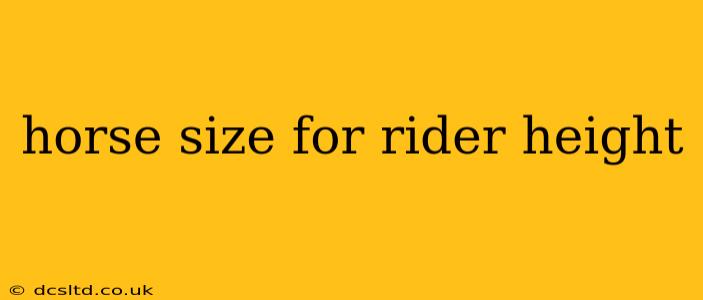Choosing the right horse is a crucial step for any rider, regardless of experience level. A significant factor in this decision is the horse's size relative to the rider's height. Getting the right match ensures comfort, safety, and a more enjoyable riding experience. This guide will help you navigate the complexities of horse size and rider height compatibility, answering many frequently asked questions.
What is the ideal horse size for my height?
There's no single perfect formula, as several factors beyond height influence the ideal horse size. However, general guidelines exist, considering the horse's height (measured in hands – a hand is 4 inches) and the rider's height. These guidelines are a starting point and should be adapted to individual circumstances.
- Children and Ponies: Children typically ride ponies, which are generally under 14.2 hands high. The specific pony size depends on the child's age, weight, and riding experience.
- Teenagers and Smaller Horses: Teenagers often begin with horses around 14.2 to 15 hands high, gradually progressing to larger horses as they grow and gain experience.
- Adults and Larger Horses: Adults typically ride horses ranging from 15 to 17 hands high. Riders under 5'4" may find 15-16 hand horses comfortable, while taller riders (5'7" and above) may prefer horses closer to 16-17 hands.
Important Considerations:
- Rider's Build: A taller, heavier rider may require a larger horse than a shorter, lighter rider of the same height.
- Horse's Build: A stocky horse of a given height might feel more substantial than a leaner horse of the same height.
- Riding Discipline: Different riding disciplines might favor different horse sizes. For example, dressage often involves taller, more elegant horses, while Western riding might involve stockier breeds.
- Experience Level: Beginners often benefit from smaller, more manageable horses.
What are the dangers of riding a horse that's too big or too small?
Riding a horse of unsuitable size presents significant risks:
Too Big: A horse that's too large can be difficult to control, leading to falls and injuries. The rider may struggle to reach the stirrups comfortably, maintain balance, and effectively manage the horse's movements. Additionally, the horse’s larger frame can increase the impact of a fall.
Too Small: Riding a horse that's too small can also be dangerous. The rider's legs might be too long, forcing an uncomfortable and potentially unsafe riding position. The horse may also struggle to carry the rider's weight, leading to strain and injury for both horse and rider.
How do I determine the right horse size for my child?
Choosing a pony for a child requires careful consideration. Pony size should be appropriate for the child's age, weight, and skill level. It's best to involve a qualified riding instructor who can assess the child's abilities and recommend an appropriate pony size. Remember safety is paramount, and it's better to start with a slightly smaller pony than one that's too large.
Can I ride a horse that is slightly bigger or smaller than the recommended size?
While the guidelines are helpful, there's some flexibility. A rider might comfortably ride a horse slightly outside the suggested height range, depending on the other factors mentioned previously. However, significant deviations from the recommended sizes should be avoided. Always prioritize safety and comfort.
What if I'm between sizes?
If your height falls between recommended sizes, consider your build and riding experience. A slightly larger horse may be better suited for a heavier rider, while a slightly smaller horse might be preferable for a lighter rider with more experience. Consulting with an experienced rider or instructor can provide valuable guidance.
Are there other factors besides height to consider when choosing a horse?
Absolutely! Height is only one piece of the puzzle. Other crucial factors include:
- Temperament: A horse's personality is as important as its size. A calm, well-trained horse is safer and more suitable for beginners.
- Training Level: Choose a horse whose training level matches your riding skills.
- Breed: Different breeds have different temperaments and physical characteristics.
- Overall Health: A healthy horse is essential for a safe and enjoyable riding experience.
Remember, finding the right horse is a process. Take your time, seek professional guidance, and prioritize safety. A well-matched horse and rider partnership leads to years of fulfilling equestrian adventures.
